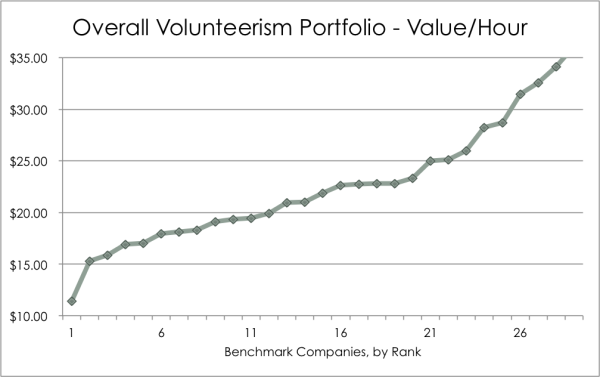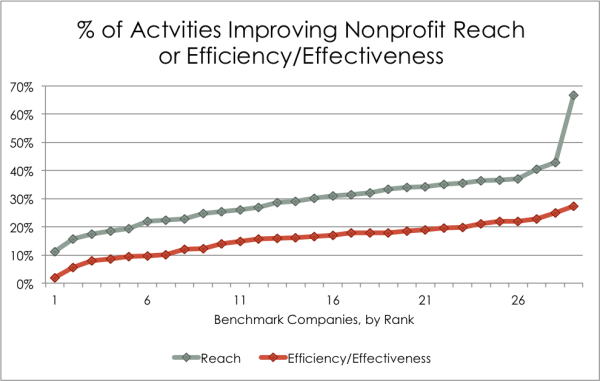Avoided cost. Volunteers help nonprofits save money by providing services for free that the nonprofits would otherwise have to pay for. You can monetize the total value of these services by multiplying the total number of reported service hours for each volunteer activity by an hourly rate for each activity type: we use the Bureau of Labor Statistics as our source for this information (e.g., Food preparation and sorting is $11.28/hour, Computer networking support is $27.90/hr., etc.).
The following benchmarking data (from our most recent dataset of 29 Volunteerism ROI Tracker companies) includes the overall average value per hour of each organization’s volunteerism portfolio. So, companies with a higher percentage of their volunteer activities dedicated to high-value activities do better in the ranking than those companies with smaller percentages of high-value activities.

The graphic below illustrates the distribution of volunteer activities performed across all of the participating companies. The majority of these activities (by hours served) included traditional, or “hands on” volunteerism, with relatively low value per hour. Skilled-based volunteerism, which on average had three times the value per hour of traditional volunteerism, made up only 15.7% of all volunteer activities analyzed.

* Excludes activities classified as “other”
This table illustrates heavy weighting of participants’ portfolios towards traditional volunteerism, as compared to higher-value skilled-based volunteerism:
> Column 1: the range of activities recorded by volunteers
> Column 2: the total hours performed of each activity
> Column 3: the value per hour of each activity
Increased capacity. Volunteers can help improve nonprofit capacity in three ways:
-
Increasing efficiency (i.e., enabling the nonprofit to use fewer resources -- in terms of time or money -- in performing its operations or delivering services)
-
Increasing effectiveness (i.e., improving the success rate of the nonprofit’s services)
-
Increasing reach (i.e., enabling the nonprofit to serve a greater number of beneficiaries)
You can measure these impacts in terms of resulting resource savings or increase in successful outcomes, and also monitor how frequently these effects occur among your volunteer projects. The following graphic illustrates how frequently volunteers reported capacity gains across our benchmarking group:

Together with the economic value of the volunteer services provided, the following table summarizes the range of these benchmark results:

N = 44,053 respondents, 29 companies
Select Findings/Best Practices. Together, these results strongly support the current trend in the sector towards encouraging more skills-based volunteerism (i.e., where volunteers apply professional-level skills) as a way to increase social impact. Additional findings:
-
Avoided cost. The same number of hours devoted to skills-based volunteerism can generate over 500% the value of traditional volunteerism (i.e., where volunteers serve as “an extra pair of hands”).
- Increased capacity. Skilled volunteers were more likely to report instances of helping nonprofits to increase their efficiency, effectiveness, or reach:




.png)
